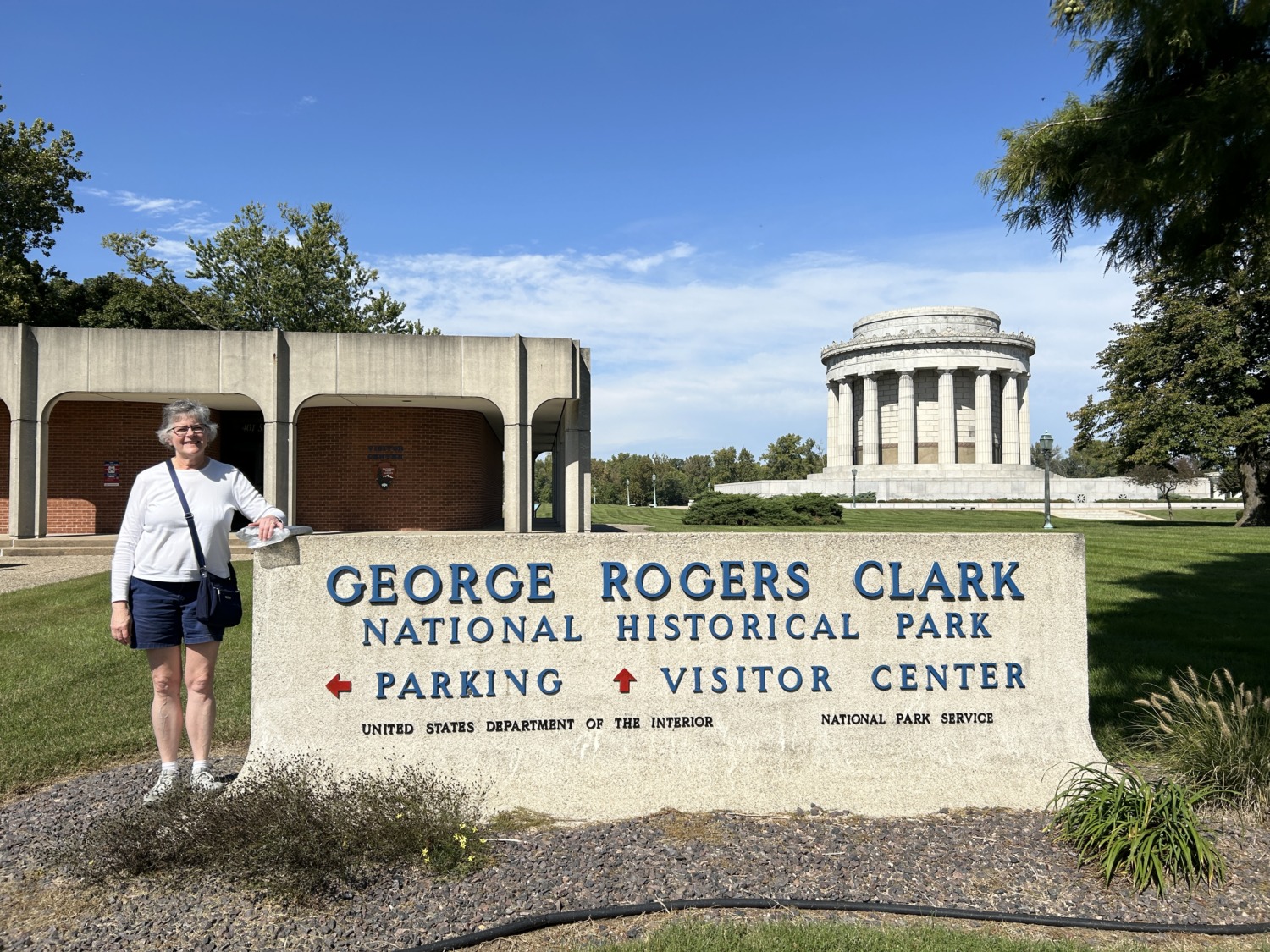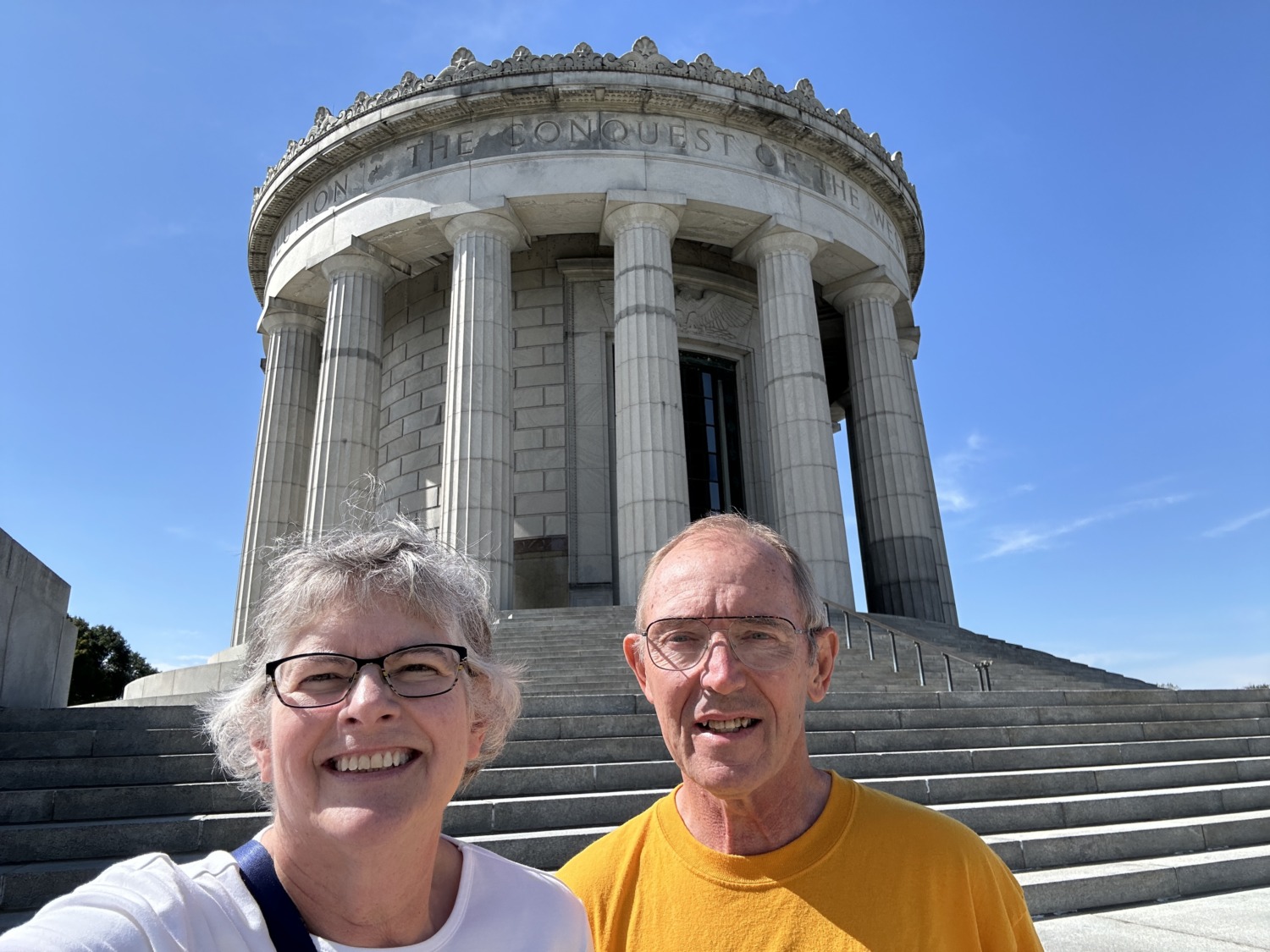Tom and I headed for George Rogers Clark National Historical Park in Vincennes, Indiana the day after hitting the Missouri parks along the Mississippi River. Tom was especially interested in going there because it is a revolutionary war park. He had also heard that they did living history there and thought it might be a good place to volunteer.
Have you ever heard of George Rogers Clark? This is the older brother of the Clark that was part of the Lewis and Clark expedition. George isn’t as famous as his younger brother. In fact, George reached the highlight of his life at age 27 and it was all downhill from there for him. Here is the history.
The British dominated a large portion of the Trans-Appalachian frontier after the French and Indian War. The Proclamation of 1763 forbid the settlement of lands west of the Appalachian Mountains. From their posts north of the Ohio River, the British sent Indian war parties against those settlers who ignored the proclamation line, including those in Kentucky.
George Rogers Clark organized the Kentucky militia to defend against these raids. Clark was not content to wait for the attacks. He decided that a major offensive campaign was needed. During the summer of 1778 Clark directed his army down the Ohio River then overland some 120 miles to capture the British posts at Kaskaskia and Cahokia along the Mississippi River, near St. Louis. Although under British rule after the French and Indian War, these posts were populated by French settlers who had no great affection for the British. Clark quickly gained their support. The French at Detroit and other northern posts, however, maintained the outward support of the British.
By Aug. 6, British Lt. Governor Henry Hamilton received news about the fall of the outposts. With a mixed force of English soldiers; French volunteers and militia; and Indian warriors, he left Detroit for Vincennes, which he reached on December 17. Then Hamilton made a fateful decision. He allowed most of his force to return to their homes for the winter. Hamilton planned to gather his forces in the spring and attack Clark’s Mississippi River posts.
Unaware that the fort was in British hands, Francis Vigo a merchant and supporter of the American cause, set out from his St. Louis home for Vincennes. As he approached the settlement, he was taken prisoner and was held for several days. Hamilton allowed him to leave. After returning to St. Louis, Vigo immediately went to Clark 50 miles south in Kaskaskia. Vigo informed Clark of the military situation in Vincennes and the British intent to attack in the spring.
Determined to capture Hamilton, Clark and his force of approximately 170 Americans and Frenchmen made an epic 18-day trek from Kaskaskia through the freezing floodwaters of the Illinois country. At times in icy water up to their shoulders, it was Clark’s determined leadership that brought them through this incredible midwinter journey. They arrived in Vincennes after nightfall on Feb. 23, 1779. The French citizens, eager to renounce the British, warmly greeted Clark’s men and provided food and dry gunpowder. Hamilton’s garrison now consisted of approximately 40 British soldiers and a similar number of French volunteers and militia from Detroit and Vincennes.
Clark’s men surrounded the fort and gave the impression of having a much larger army. The American soldiers, who were experienced woodsmen, could maintain a rate of fire that convinced the British that the army indeed was large in number. These woodsmen were armed with the famed long rifle. And their aim was accurate. To further unnerve the garrison, Clark ordered tunneling operations to begin from behind the riverbank a short distance from the fort. Such tunnels were used to plant explosive charges under fort walls or beneath powder magazines. Barricades were thrown up and entrenchments were dug to provide additional cover.
An Indian raiding party, sent out by Hamilton to attack American settlers along the Ohio River, returned to Vincennes. Their entrance came during a lull in the battle. The unsuspecting warriors, gleefully yelling and firing their weapons in the air, realized their mistake too late. Several Indians were killed or wounded by the frontiersmen while others were captured. Clark ordered five of the captured warriors to be tomahawked in full view of the fort. The executions were intended to heighten the psychological pressure upon the British. They also illustrated to Indian observers that the redcoats no longer could protect those tribes who made war on the Americans.
Following this grim scene, the lieutenant governor reluctantly agreed to Clark’s terms for surrender. The defeated British army marched out of Fort Sackville and laid down their muskets before their victors. The surrender occurred 10 a.m., Thurs., Feb. 25, 1779.
Although unable to achieve his ultimate objective of capturing Detroit, Clark successfully countered British and Indian moves during the remainder of the conflict. The young Virginian prevented the British from achieving their goal of driving the Americans from the Trans- Appalachian frontier. As a result of Clark’s military activities, the British ceded to the United States a vast area of land west of the Appalachian Mountains. That territory now includes the states of Ohio, Indiana, Illinois, Michigan, Wisconsin and the eastern portion of Minnesota.
When Tom and I arrived at George Rogers Clark National Historical Park, we started off in the Visitors Center. We watched a movie on the battle for Fort Sackville which helped explain the importance of the victory. We also checked out the small museum. After talking to the ranger and finding out that living history programs only take place once a year, we walked the grounds and visited the memorial.
The grounds were small but beautiful, very similar to the grounds of Gateway Arch. George Rogers Clark National Historical Park is basically a big lawn next to the Wabash River. The centerpiece of the park is a large memorial building (think Jefferson Memorial in DC). Tom and I climbed the steps to the memorial, but it was locked. It is only open when there a ranger has time to be up there. Although it is a very grand building, we thought it was a bit overdone for the importance of the battle. But the people of Vincennes were obviously very proud of their town’s history.
After leaving the area around the Visitors Center, we checked out some of the other historical spots in town. They are not a part of the George Rogers Clark Historical Park. We saw the old French Quarter and a collection of houses that are part of a state historic site. The most interesting building was Grouseland, the home of William Henry Harrison, 9th President of the United States.

Vincennes is a beautiful city and worth exploring. It would be a good place to stay overnight. There are Indian mounds, historic buildings, restaurants, the park, and the Ouabache Trail. The George Rogers Clark National Historical Park is interesting but can easily be seen in a couple of hours, leaving plenty of time to explore other things in the area.



